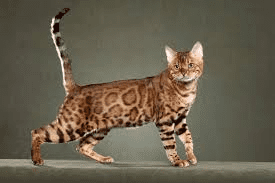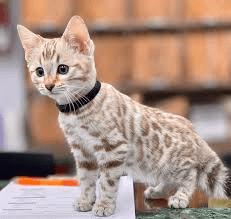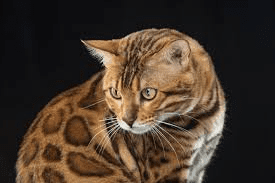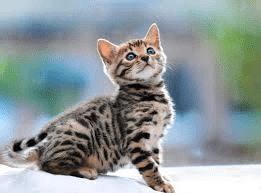Some people often ask to find out whether Bengal cats are hypoallergenic or are there Bengal Cat Hypoallergenic cats? Well, the response is that they are actually hypoallergenic, but before you can fully say they are hypoallergenic, you must understand that the word hypoallergenic does not literally mean allergen-free.
Rather, it simply means relatively unlikely to cause an allergic reaction. Bengal cats are less likely than other cat breeds to trigger allergic reactions in people, and this is why.
Fel d 1, a protein present in cat saliva, skin cells, and urine, is the most prevalent cat allergen. This protein travels through the air on cats hair. Its weight causes more people to react to this cat protein than to dog allergens. Because fel d 1 is so light, it stays in the air for a longer period of time and is therefore more likely to enter the lungs when a person with this allergy enters a room with cats.
Due to its extreme stickiness, once it touches the surfaces of a house, it remains there. Bengal cats are not among the Oriental breeds that produce less Fel d 1 than other cat breeds.
A person may, however, discover that they can be around Bengal cats if they are only moderately or barely sensitive to Fel d 1. Bengal cats shed less than some other breeds because they are single-coated and have less fur than double-coated cats.
This means that the protein has fewer hairs to hop or stick onto and enter the air. Additionally, some Bengals still have the fluffy coat quality that breeders refer to, as their hair is very short and soft like rabbit fur. Because of the sleekness of this coat type, Bengals require less grooming and are clean at all time.
Less grooming results in less saliva coating the Bengal’s coat and less airborne release of Fel d 1-containing hair and debris. Some allergy sufferers may be able to own a Bengal because of the HEPA air filtration system’s ability to filter out some of the protein particles that are in the air.
The quality of your cat’s skin and fur will also improve if you feed it a raw diet. When your cat is fed a diet low in protein, because it contains ingredients other than meat, organ, and bone, the skin and fur of your cat will not get enough protein to maintain peak condition, because the skin of the cat consumes 30% of the protein your cat eats each day.
Your cat will receive all the nutrients it requires for proper health by being fed a nutritionally complete raw diet instead of one that contains any ingredients that are harmful to its well-being.
Additionally, Omega 3 Fatty Acids can be added to a raw diet to make the skin supple and healthy, which reduces debris and shedding. After putting a cats on a raw diet, some allergy sufferers will experience a complete disappearance of their symptoms.
In conclusion, Bengals are hypoallergenic since they groom themselves less frequently than cats with double or course coats. The amount of hair and debris released into the air can be further decreased by feeding your Bengal cat a raw diet rich in omega 3. This makes owning a Bengal cat possible. However, this does not ensure that Bengal cats will not aggravate every allergy sufferer.
Read Also: Sphynx Cat Adoption and Complete Grooming Care Guide
How can you determine whether Bengal ownership will be a possibility for you? This is a question everyone will like to ask. You can visit a house with Bengal cats, wait 24 hours, and then assess how you respond.

The best way to find out if someone you know has one or more Bengal cats is to go visit their home. You can go to the breeder’s house, but since allergens accumulate, it might not be a good place to conduct a test. When you enter a home with many Bengals, you are exposed to high concentrations of the allergens even though individual Bengals produce less of them.
What safeguards can you put in place at home to lessen the likelihood of an allergic reaction? Another interesting question right? The most important safety measure was mentioned earlier that you should feed your cat a raw diet rich in Omega 3 to keep its skin and fur in top condition.
Additionally, purchasing a HEPA filtration system will remove some allergens from the air. Regularly clean your house. Lessen the number of surfaces that can collect allergens, such as carpet in place of hard flooring, leather in place of fabric for furniture, and plastic or wood for window coverings in place of fabric.
As the protein is also in the cat’s urine, assign someone else to cleaning the litter box i.e food box or feeding bowls. Use pet wipes to clean your cat or give it a bath if necessary. One-third of Americans who suffer from allergies, according to Health Line, are allergic to cats and dogs. Cat allergies are twice as common as dog allergies.

Such allergies are brought on by the immune system’s antibodies attacking the allergen instead of the harmful substances that the body normally fights off. Itching, a runny nose, and congestion are some of the effects of this.
The cat’s salivary glands, hair, urine, and dead skin all contain allergens. These allergens can trigger allergic reactions when inhaled or touched. The debris shed by a shedding cat contributes significantly to the allergen issue.
Bengal cats, thankfully, rarely shed much fur. Some people may lose more weight due to stress, anxiety, a change in the weather, or their dietary intake. The causes of this are typically fairly quick and simple to fix.
Simply combing it once a week will take care of a Bengal’s coat. This eliminates or greatly reduces the allergic reaction by removing dead hair that has accumulated in the fur.
However, if you do this too frequently, it may harm the skin’s natural oils and have the opposite effect. You can also consult an allergist for additional guidance, of course. Cat saliva may also cause an allergic reaction in some people.
The reaction site may become red, painful, and swollen as a result of these allergic reactions. It can be very beneficial in the moment to start immediately minimizing the allergic reaction by having a topical allergic medication in hand in case one occurs.

This shouldn’t deter stop allergy sufferers from choosing a Bengal. Yes, the breed is notorious for biting, but they are also perceptive and simple to train. It is usually simple to teach a Bengal to stop biting their owner, other people, and especially the hand that feeds them.
Claw scratching occasionally cause allergic people to react. It can be equally painful and irritating and has a similar effect to a cat bite. The Bengal can be easily trained to lose this characteristic.
A Bengal cat can be an excellent choice for an allergic person looking to own a cat because of its low level of shedding, rarely allergic-reaction, and trainable propensity to not bite or scratch.
The Bengal cat price differs depending on your location and other factors that determines the price. Additionally, Bengal cats comes in different unique colors like; the silver Bengal cat, the black Bengal cat, etc. thereby giving you the opportunity to choose your preferred color.
Read Also: Illegal Grazing/Logging and their Negative Effects on Forest and Wildlife






